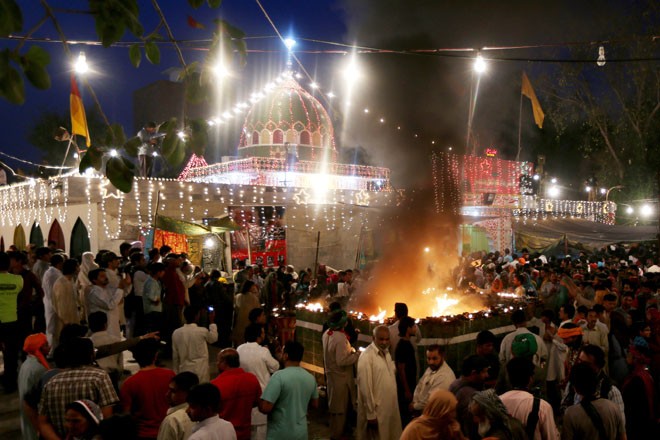

The initiation of the spring season in Lahore was celebrated by kite-flying and display of saffron colours on basant, its middle phase by the holding of the annual festival of Mela Chiraghan in the last week of March and its culmination in the shape of baisakhi when around mid-April the harvesting of the crop was marked by music and dance.
It was a two-month phase in which the various phases of basant/ bahar were celebrated by people not known for holding back their desire to be merry and exuberant.
Basant and kite-flying, despite feeble gestures of resumption, have been banned through official edict -- more under the pressure of those who want a puritanical version of life to be practised in the name of religion. Baisakhi has been relegated to the margins by a society which is fast becoming urban and losing its connection with the pastoral habitat that sustains it. Since Mela Chiraghan, too, due to the expanding city has shrunk in size and importance, it is fair to ask -- do the Lahoris or Punjabis have a decent festival to celebrate this season of regeneration and rebirth, more located within traditions and their soil?
In a society that was principally agricultural the relationship with the land and seasons was primary. But, as society has moved into an industrialised phase, the character of people’s communion has started to change. The concerns have been less rooted in the seasons and the nature’s power of regeneration. Instead seasons are only viewed in terms of pleasant or harsh weather and regeneration has been converted into economic recovery from recession. Industrial fairs are held brandishing industrially-produced goods backed by huge advertising campaigns.
The official sanitised functions that are stage managed with not so hidden agendas have replaced them now. The leisure too has been taken up by television, cinema, internet and mobiles which are not terribly social but insist on offering pleasure and entertainment to individuals as each can access his own preference.
The problem of culture arises with the expansion of religions or ideologies that outgrow their physical surroundings into lands that have a different cultural mix and complexion.
During the thousand-year-rule of the Sultanate and the Mughal rule, the most cherished spring festival, Nauroz, was celebrated from top to bottom by the ruling elite and the people at large. The very strong hue of Persianised culture linked the festival to the lands as far away as Turkey, extended Iranian territories in Central Asia and India.
Basant and baisakhi have their origins in our land. Baisakhi is celebrated across the region by the Buddhists as a very auspicious day. Vaisakhi, Vesakha, Vaisakha, Vesak or Wesak commemorates the birth, awakening and enlightened passing away of Buddha Gautama. The Sikhs alos celebrate the beginning of the month of baisakh. To many now in Pakistan, it is only considered a Sikh religious festival, especially situated round the shrine in Hasan Abdal. It is a seasonal festival that has been celebrated across the land to celebrate a good yield and pray for the fertility of the soil so very essential to sustain life.
The birth of Khalsa was celebrated on baisakhi in the year 1699, when the 10th Guru of the Sikhs, Guru Gobind Singh laid down the foundation of the Panth Khalsa that is the Order of the Pure Ones.
For Hindus, it is the start of the new year, and is celebrated with requisite bathing, partying, and worshipping.
It is believed that thousands of years ago, Goddess Ganga descended to earth, and many Hindus gather along the sacred Ganges River for ritual baths in her honour. The action is centered in the holy cities along the Ganges in north India or in Srinagar’s Mughal Gardens.
Mela Chiraghan was the most important cultural event of Lahore till about a few decades ago. It drew people from all walks of life including a large number of performing artistes who mostly sang the kalam of Shah Hussain and whipped themselves up into an ecstatic frenzy through the traditional dance form of dhamaal. The shrine of Shah Hussain, before partition, was the focal point for celebrating basant as well. Both basant and Mela Chiraghan were celebrated around the shrine and in Shalamar Gardens.
In 1960s, Mela Chiraghan was shifted out of Shalamar Gardens on the official plea that the huge congregation caused damaged to the monument. The area round the shrine was open and un-constructed and provided adequate space for the mela. But now since the entire area is built up, the mela held on the shrine and the narrow by-lanes around is cramped for space. A fire is lit on in the compound of the shrine and it is not allowed to be extinguished during the three days of the mela as many pray for the fulfilment of a wish, some bow their heads in thanksgiving while many more just sing and do dhamaal on the beat of the dhols as a cathartic cleansing of the soul.
Shah Hussain is surely one of the greatest poets of Punjabi. He cut a defiant figure, rebelling against sanctimonious piety, dehumanising hierarchy and subjugating imperial rule. Though he came after Baba Fareed and Guru Nanak, in many ways he set the formal standards of Punjabi poetry. He is credited with raising the kafi to a definitive poetical form and using Heer and Ranjha as symbolic figures in the triumph of truthful love against the castes and creeds that perpetrated division in society.
The Mela comprises the bazaar as people come and do a lot of buying and selling, and these become the centres of exchange and trade offs. Not so many theatre companies pitch their tents now, being replaced by minor circus and variety programmes. The ambience of the Mela is still very rural, the market and bazaar have wares usually utilised by the villagers.